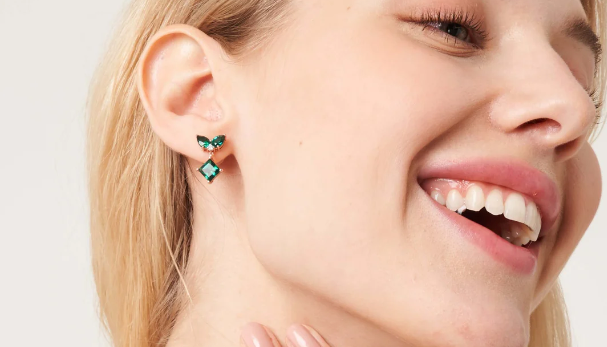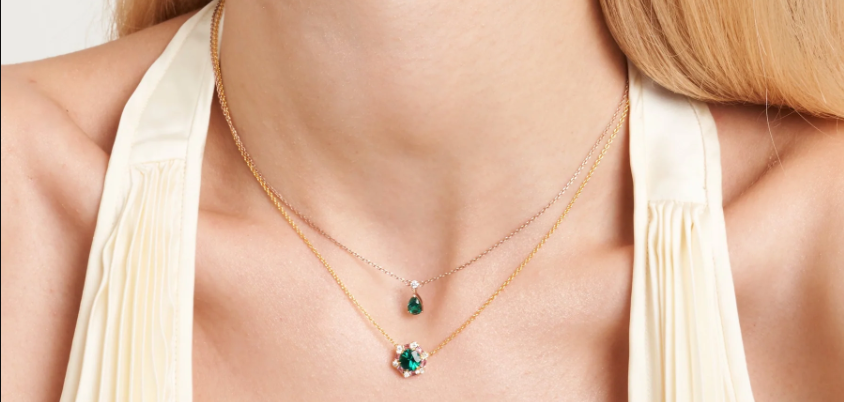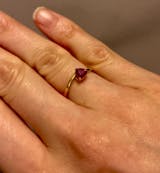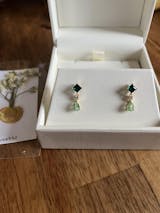
Care Guide: Keeping Your Emerald Earrings Shimmering for Years
Table of Content: Inside this Article
...With their rich green hue, Emeralds have captivated hearts for centuries. When set in earrings, they become a timeless piece of jewelry.
However, to keep them shimmering, it's essential to understand and practice proper care.
In this article, we'll tackle the essential tips and techniques to ensure your emerald earrings remain as stunning as the day you got them.
Understanding Emeralds
Understanding emeralds goes beyond appreciating their enchanting green hue; it involves recognizing their unique characteristics and vulnerabilities.
Emeralds, classified as beryl minerals, are renowned for their vibrant green color, which comes from trace amounts of chromium and/or vanadium.
Emeralds are durable.
However, unlike diamonds, which rank highest on the Mohs scale of mineral hardness, emeralds are considerably softer, typically ranging between 7.5 to 8 on the scale.
This means they can be more prone to scratches and chips. Thus, it is essential to understand these treatments as they affect how you should care for and clean the gemstones.

Daily Wear and Care Emerald Earrings Tips
When incorporating emerald earrings into your daily ensemble, it is important to remember that while they add a touch of elegance, they also require a bit of extra attention.
For instance, when you're getting ready in the morning, make it a habit to put your emerald earrings on last.
This way, you avoid exposing them to the potentially harsh chemicals found in hairsprays, perfumes, or makeup, which can dull their vibrant green over time.
Moreover, consider your day's activities when deciding to wear your emeralds. If you're planning a day filled with outdoor adventures or hands-on tasks, it might be wise to leave your precious gems at home.
Activities like gardening, cooking, or sports could expose the earrings to rough treatment, increasing the risk of scratches or chips. And, of course, remember to take them off before diving into household chores, especially those involving cleaning agents.
Emeralds, while hardy, aren't fond of the rigors of daily grit and grime.
By treating your emerald earrings with this level of care, you ensure they remain as dazzling as the day you first wore them, ready to add that special sparkle to your next elegant outing or special event.

Cleaning Emerald Earrings
Cleaning is vital for maintaining the shine and shimmer of your emerald earrings. Use a soft brush and mild soap solution, gently brushing the stones and setting. Rinse with lukewarm water and dry with a soft cloth.
When it's time to clean your emeralds, think of it as a gentle pampering session for your precious gems.
Begin by preparing a mild soap solution; a bit of gentle, non-detergent soap mixed with lukewarm water works wonders.
It's important to ensure that the water isn't too hot or too cold, as extreme temperatures can be unkind to emeralds, especially those with oil treatments or inclusions.
Next, take a soft-bristled brush - perhaps a baby toothbrush or a special jewelry brush.
Gently brush the emerald stones and their settings, paying close attention to crevices where dirt and grime tend to hide.
Imagine you're brushing the wings of a butterfly; that's the level of gentleness you're aiming for.
This soft brushing helps to remove any accumulated oils or particles that might be dulling the emerald's natural brilliance.
After the brushing, rinse the earrings carefully in a bowl of lukewarm water. It's a good idea to avoid rinsing them directly under a tap, as the pressure might be too strong, or worse, they might slip down the drain.
Once rinsed, pat them dry with a soft, lint-free cloth.
Avoid using paper towels or rough fabrics, as these can scratch the surface of the emeralds.
Remember, the key to cleaning your emerald earrings is gentleness and care.

Storage Solutions for Emerald Earrings
Storing your emerald earrings correctly is just as important as wearing and cleaning them with care.
Think of it as tucking them into bed; you want them to have a safe, cozy spot where they can rest undisturbed and protected.
A fabric-lined jewelry box is an ideal home for your emerald earrings.
The soft lining cushions the earrings, shielding them from any harsh surfaces that could cause scratches.
If you have a jewelry box with individual compartments or slots, even better!
This ensures that each earring stays in its own space, free from rubbing against other pieces that might cause damage.
If you don't have a fabric-lined jewelry box, a soft jewelry pouch is another great option.
These pouches can be made of materials like velvet or silk, offering a gentle environment for your emeralds.
When using pouches, it's a good idea to place each earring in its own pouch to avoid them knocking against each other, which is particularly important if the earrings have intricate designs or protruding settings.
Emeralds don't like to be jostled around too much.
They prefer a stable, dry environment.
Avoid places with extreme temperature changes or humidity, as these conditions can affect the gemstones over time.
Also, keep them away from direct sunlight when storing, as prolonged exposure can affect the color of the emeralds.
 Diana Gold Earrings Emerald & Diamond
Diana Gold Earrings Emerald & Diamond
Regular Emerald Earrings Check-Ups
Scheduling regular check-ups with a jeweler for your emerald earrings is akin to taking a beloved car for its routine service; it's about ensuring everything is in top-notch condition.
These check-ups are essential as they provide an opportunity for a professional to closely examine the settings and stones of your earrings.
Over time, even the most securely set emeralds can become loose, especially if the earrings are worn frequently.
A jeweler will check for any signs of wear and tear, making sure the prongs or bezels holding the stones are not bent or weakened.
This proactive approach not only maintains the structural integrity of your earrings but also helps preserve the emerald's natural beauty and brilliance.
In addition to checking the settings, the jeweler will inspect the stones themselves.
The expert eye of a jeweler can spot these issues early on, allowing for timely intervention.
Regular professional assessments can extend the life of your emeralds.
Ever found yourself mesmerised by a pair of emerald earrings, wondering how they'd look on you? You're not alone! These green gems have a way of capturing our hearts, whether they're dangling elegantly or nestled snugly as studs. But did you know there's a whole world of emerald earring styles out there, each with its own unique charm? From vintage-inspired designs that whisper tales of the past to cutting-edge creations that scream modern chic, there's an emerald earring for every mood and moment. Curious to discover which style might be your perfect match? Our playful guide to emerald earrings styles is just the treasure map you need to navigate this glittering green landscape. Who knows? Your next favourite pair might be just a click away!
Repairing Damaged Emerald Earrings
If, despite your best efforts, your emerald earrings do sustain damage, it’s important to know that professional jewelers often possess the skills to repair or restore them.
Addressing these issues promptly is crucial.
Think of it as addressing a small crack in a beautiful vase; the sooner it's fixed, the less likely it is to develop into a bigger problem.
If an emerald becomes chipped or the setting is damaged, a skilled jeweler can often make the necessary repairs, restoring the earrings to their former glory.
In some cases, if an emerald is significantly damaged, it might need to be re-polished, re-cut, or even replaced.
These decisions should be made in consultation with a trusted jeweler, who can advise on the best course of action.
Repairing high-value items like emerald earrings not only requires technical skill but also an understanding of the gemstone's value, both monetary and sentimental.

Insurance and Warranty
Opting for insurance for your emerald earrings is like having a safety net; it provides peace of mind knowing that your valuable and sentimental pieces are protected against loss or significant damage.
Jewelry insurance can cover a range of incidents, from theft to accidental damage, making it a wise choice for high-value items like emerald earrings.
It's important to read the terms of the insurance policy carefully to understand what is and isn't covered, and under what conditions.
Some policies might require regular appraisals to ensure the insurance value remains up-to-date with the current market value of the earrings.

Understanding and utilizing warranty services offered by jewelers or manufacturers is equally beneficial.
Warranties often cover defects in craftsmanship or materials and can be a lifesaver if you encounter such issues.
However, warranties typically don’t cover damage from daily wear or accidental damage, which is where insurance comes in.
Combining both insurance and warranty services provides a comprehensive safety net for your precious emerald earrings, ensuring you can enjoy their beauty with less worry about the unforeseen.
This dual approach to protection helps in maintaining both the aesthetic and financial value of your earrings, allowing you to cherish and perhaps even pass them down as an heirloom with confidence.
Keeping your emerald earrings shimmering for years requires a combination of daily care, regular professional maintenance, and mindful handling.
With these tips, your emerald earrings will continue to dazzle and captivate.

Frequently Asked Questions
How often should I clean my emerald earrings?
- Regular cleaning every few weeks is recommended, or more frequently if you wear them daily.
Can I wear my emerald earrings while swimming?
- It's best to avoid wearing them in chlorinated or saltwater to prevent potential damage.
Should I insure my emerald earrings?
- Given their value and vulnerability, insuring your earrings is a wise decision.
Can I use a regular jewellery cleaner on my emeralds?
- Always opt for cleaners specifically designed for emeralds or use mild soap and water.
How can I tell if my emeralds are damaged?
- Look for any changes in color, clarity, or the appearance of scratches or chips.






